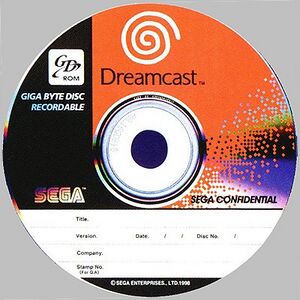GD-ROM
From Sega Retro
The GD-ROM (Gigabyte Disc Read Only Memory) is the optical media used by the Sega Dreamcast console (as opposed to a standard compact disc), as well as the Sega NAOMI, NAOMI 2, Triforce, and Chihiro arcade systems. GD-ROMs have the capability of holding a maximum of 1 GB of data, rather than the standard 650-700 MB of a CD.
Developed by Yamaha, the GD-ROM is a proprietary format which works by packing the pits on the disc closer together to store more data. Along with more storage, the GD-ROMs provide an extra level of copy protection as they cannot be reproduced using a standard CD-Writer.
Regions of a GD-ROM Disc
The are 3 distinct regions when you look at the data (reflective) side of a GD-ROM disc.
- The low-density inner track (dark gray) is in the standard CD format, and contains about 35 MB (4 mins) of data. In most cases, this contains an audio track with a warning that the disc is for use on a Dreamcast, not an ordinary CD player. The CD section also contains a data segment, readable in PCs (though most discs only contain text files identifying the game, its copyright and bibliography). Some games, however, contain some bonus material for home computer users.
- The outer track (light gray) contains about 1 GB (112 mins) of data but is written in a high density format which cannot be accessed by normal CD-readers. This section contains the game data.
- The area between the two tracks (black) does not contain data and acts as a border. In this ring, the following text is stored. CDDA can also be stored here (with actual audio tracks such as Quake 3 uses) but the CDDA here cannot be read by a normal CD player (most games use ADX files for music though and save the rest of the disc space for more game data.)
- "Produced by or under license from SEGA Enterprises LTD"
- "Trademark SEGA"
A normal CD reader will only read the first inner track and will not read past the black area, because according to the TOC read by the normal CD-reader there is no data there. With a modified firmware that looks for a second TOC in the high-density region it is possible to read data from the high-density region even on a normal CD-reader. One can also utilize a "swap-trick" by first letting the CD-reader read the TOC off a normal CD with a large track and then swap that disc with a GDROM in a way that avoids alerting the CD-reader that a new disc with a new TOC has been inserted. It is then be possible to read as much data from the high-density region as the TOC from the first disc indicates.
The details of the high-density region aren't really known, but most likely the pits are just packed tighter than normal but still within tolerance since there is no problem to get a standard CD-ROM to read data. Claims that SEGA dispensed with error correction as a way to increase the payload are not true. GDROMs use the same error correction as standard CDs but since data is packed tighter, scratches will affect more data and thus be more detrimental.

